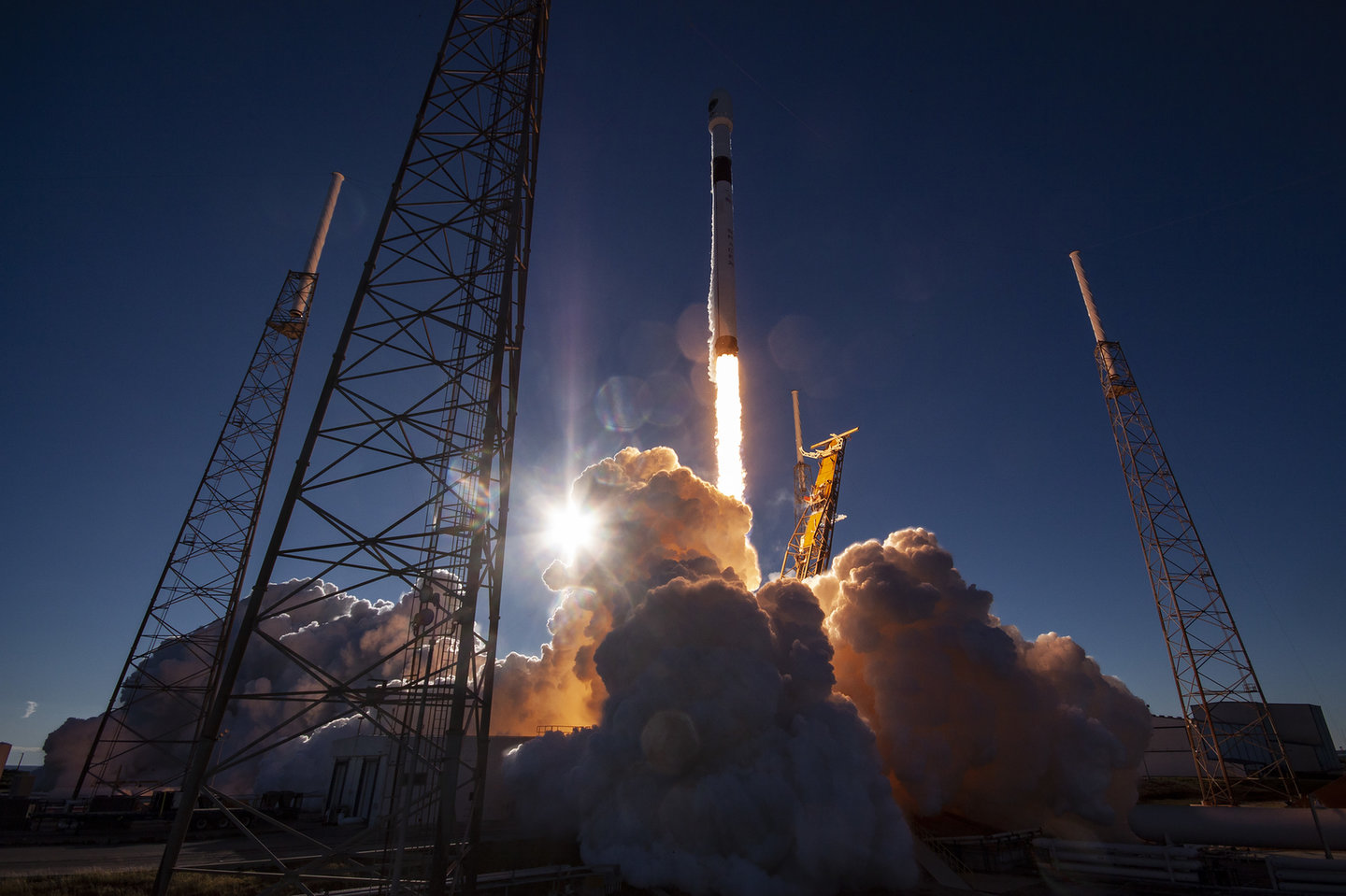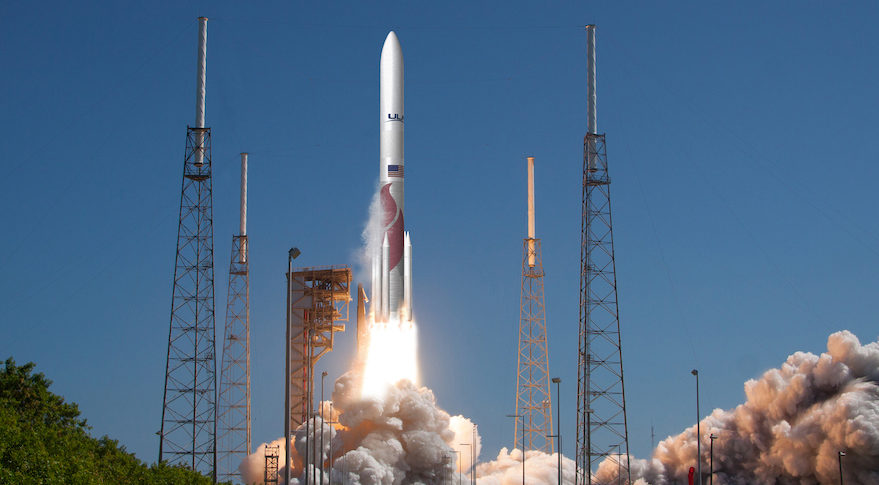SPACE
Reusable rockets and the limits of space: onboard the STP-2 mission
In June the US Department of Defense (DoD) used SpaceX’s Falcon Heavy for the first time to propel several satellites into orbit. It was also the first time the DoD had reused boosters from a previous launch, which then landed again for further use. Grant Turnbull asks, is this the beginning of a new era of space launches for the US military?

// Falcon Heavy takes off for the STP-2 mission. Image: SpaceX
In the early hours of 25 June 2019, SpaceX’s Falcon Heavy lifted off from Launch Complex 39A at Kennedy Space Center in Florida, carrying a total of 24 satellites for research and experimentation into orbit. This launch - the third in total for the Falcon Heavy launch vehicle since its maiden launch last year - formed part of the US DoD’s Space Test Program-2 (STP-2) that was managed by the USAF’s Space and Missile Systems Center (SMC).
For the STP-2 mission, the newly reorganised SMC, based at Los Angeles Air Force Base in El Segundo, California, also partnered closely with NASA and the National Oceanic and Atmospheric Association (NOAA).
Two firsts for a challenging launch
This was the first time that the Falcon Heavy had been used to launch several payloads into multiple orbits, making it “among the most challenging launches in SpaceX history with four separate upper-stage engine burns”, according to SpaceX.
The 24 payloads were blasted into three separate orbits and included the Demonstration and Science Experiment (DSX) satellite for the Air Force Research Laboratory, as well as NOAA-sponsored satellites that form part of the COSMIC-2 constellation. Other notable payloads were four NASA experiments, five small satellites and eight Poly-Picosat Orbital Deployers containing eleven CubeSats. It is hoped that these advanced satellites will provide valuable data for areas such as weather forecasting, space environmental monitoring, propulsion and communications.
The mission was also the first instance that the US DoD reused launch vehicle hardware: the side boosters were the same units that were used to launch the Arabsat-6A on a Falcon Heavy in April 2019. These side boosters successfully completed a tandem landing at SpaceX’s Landing Zones 1 and 2 at Cape Canaveral Air Force Station in Florida after the launch (the troublesome main booster has yet to make a successful landing, however).
“This was a momentous launch for NASA, NOAA, and the DoD,” said Colonel Dennis Bythewood, program executive officer for space development, in a statement. “The SpaceX Falcon Heavy allows the air force to begin using previously flown rocket technology to further reduce the cost of launch. This mission demonstrated SMC’s continuing commitment to leverage the most innovative technologies to deliver cost-effective space capabilities.”

The GPS III SV01 mission in December 2018 was SpaceX’s first national security launch. Image: SpaceX
Recycling rockets: is the USAF ready?
This launch is providing the US DoD and USAF with valuable insights and data into how SpaceX reuses rockets from previous launches, which is seen as a key factor when it comes to driving down the cost of putting national security assets into space. Lessons learned will eventually inform the air force’s mission assurance standards, and pave the way for National Security Space (NSS) missions to be conducted with reusable rocket technologies from commercial vendors.
“This SpaceX Falcon Heavy launch allows the air force an opportunity to learn more about launch vehicle reusability, reliability, and application to future National Security Space missions,” noted Colonel Robert Bongiovi, director of SMC’s Launch Enterprise.
The USAF already uses SpaceX to conduct NSS missions. The company passed a key milestone in December 2018 when one of its Falcon 9 rockets lifted off from Cape Canaveral with a next-generation GPS III payload, supplementing 31 legacy GPS satellites already in medium-earth orbit. This mission - known as GPS III SV01 - was SpaceX’s first national security launch and was the result of a competitively awarded Evolved Expendable Launch Vehicle (EELV) contract.
“The USAF has, for the time being, requested that the Falcon 9 Block 5s not use their reusable capability.”
The EELV has a long and drawn out history, with SpaceX launching several legal challenges against the USAF to ensure it could compete for launch contracts against the incumbent United Launch Alliance (ULA) - a joint venture between Lockheed Martin and Boeing - which often won “block-buy” launch contracts without competition. There were also issues with ULA’s Atlas V rocket and its RD-180 main stage engine sourced from Russia, which has subsequently spurred domestic R&D investment for US-built alternatives using Launch Service Agreement (LSA) funding.
SpaceX was eventually contracted to launch its first NSS mission as part of the EELV in 2016, with four additional launch contracts now in place using the Falcon 9 rocket. The USAF has, for the time being, requested that the Falcon 9 Block 5s not use their reusable capability, flying without the landing legs and stabilisation fins on the boosters that usually help them touch back down.
This could change in the future, especially as two-decade-old EELV transitioned into the National Security Space Launch (NSSL) programme as of March 2019, notably dropping the “expendable” moniker, as directed by Congress.
“In carrying out the National Security Space Launch programme, the Secretary of Defense shall provide for consideration of both reusable and expendable launch vehicles with respect to any solicitation occurring on or after March 1, 2019,” states the FY2019 National Defense Authorization Act.

DoD is funding the development of ULA’s new Vulcan Centaur rocket. Image: ULA
Next-generation national security launches
In the near future, the US DoD is expected to contract two companies for a five-year block of national security launches, with the air force releasing a request for proposals in May for the phase II launch service procurement (LSP) contracts. The LSP is expected to use funds from FY20 and FY24 fiscal budgets for launches up to 2027.
SpaceX will likely be up against its old rival ULA - which is developing its new Vulcan Centaur rocket - but also companies such as Jeff Bezos’ Blue Origin and its New Glenn launch vehicle, and Northrop Grumman Innovation Systems’ (NGIS) OmegA.
“While the launch of the STP-2 mission signifies a major step forward for commercial vendors such as SpaceX to be involved in USAF programmes, there are still challenges for the launch services enterprise.”
ULA, Blue Origin and NGIS all received DoD-led LSA development funding worth over $2bn for their respective launch systems in October 2018. Notably absent from the list of companies contracted for next-generation launch systems is SpaceX; reports have emerged stating the company has now begun legal action to protest the contracts. The decision to not award a contract to SpaceX means the it will have to bear the R&D costs for a next-gen launch vehicle, which the company argues puts them at a competitive disadvantage.
So while the launch of the STP-2 mission signifies a major step forward for commercial vendors such as SpaceX to be involved in USAF programmes, as well as establishing the use of reusable rockets, there are still challenges for the launch services enterprise.
USAF officials have the significant task of ensuring that new, reusable rockets present a low risk for launching national security assets, while also juggling procurement issues as competitors ruthlessly vie for lucrative contracts in the future.